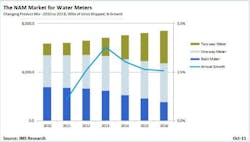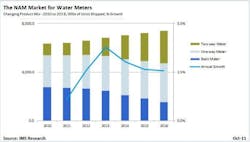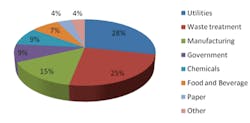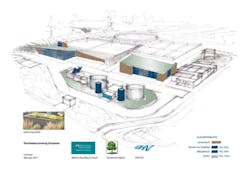Water demand has soared exponentially across the Middle East alongside population, urbanisation and improving lifestyles. It hasn't helped that low water tariffs are disproportionate to high production costs. Vivek Gautam provides an overview of MENA countries and discusses why policy reforms could be required to address demand issues.
Historically, water unavailability has been a key concern across the Middle East and Africa. Many countries in Middle East and North Africa (MENA) have renewable water resources per capita less than 1000 m3/year; the level that defines water scarcity.
Furthermore, the geographic distribution of these limited water resources is highly uneven. Over 80% of the region is desert and receives little or no rainfall. Water supply provisions under such conditions have always been a key policy issue with social, economic and environmental ramifications. In the past it has been erratic rainfall and prolonged drought periods, widely believed to be manifestations of climate change, which have added a new dimension to the problem. This is particularly the case with Syria, Jordan, Israel and Algeria, which are facing severe water shortages.
While supplies are constrained, the demand for freshwater over the years has continued to increase at a rapid pace. This increase in demand is a result of several interplaying forces. Across MENA, the agricultural sector is the prime consumer of water. In some countries, it accounts for over 80% of the total annual water withdrawals. Agricultural subsidies, improving irrigation and pumping technologies and the discovery of fossil groundwater reserves have helped expansion of agricultural activity.
Groundwater supplies
In several areas, water demand for irrigation far exceeds the natural recharge of groundwater reservoirs. Over-extraction of aquifers has led to a decline in the water table. At the same time, groundwater quality has deteriorated due to an influx of saline water from laterally surrounding areas, excessive use of fertilisers and localised discharge of brine and sewage effluent into deserts.
In the case of the municipal sector, water demand has been soaring due to growing population, urbanisation and improving lifestyles. In the resource-rich Gulf Cooperation Council (GCC) countries, per capita household consumption is much higher that the per capita consumption in some developed societies. For instance, in Abu Dhabi, the per capita demand varies from 170-200 liters per day in flats to as high as 270-1760 liters per day for people living in villas.
In urban areas, a large proportion of desalinated water is used for household gardening, maintaining public and private parks, car washing, etc. Water tariffs are low and disproportionate to the high production cost, thereby allowing such extravagant use of this scarce resource. Besides agricultural and municipal sector, expanding industrial activity too has contributed its fair share towards the overall water demand.
With many countries approaching the limit of water resource development and others reeling under severe supply shortages, the problem of water scarcity is turning into a crisis. Governments and planning agencies are being forced to think of alternative options to ease the situation. Although doing away with freshwater supply augmentation projects may not be possible, there is a strong case in favor of tapping non-conventional water resources like sewage and industrial effluents, which have traditionally been neglected. Industry experts are of the opinion that policy reforms are required to address demand side issues, while addressing supply side problems require practicing integrated water resource management.
Wastewater recycling
From the economical and environmental standpoint, wastewater reclamation and reuse makes good sense. It can reduce or eliminate health and environmental hazards associated with effluent discharges. At the same time, it generates an alternative resource and thereby prevents immediate investment in costly water supply schemes (storage, transfer or desalination plants).
Despite these potential benefits, so far wastewater reuse across most MENA countries has remained limited. One of the impeding factors is inadequate wastewater infrastructure. Though MENA countries have made considerable progress in extending sewage collection network in urban areas, treatment capacities remain uneven. Much of the collected wastewater is discharged without any treatment into the sea or desert. Even where a considerable percentage of the collected wastewater is treated, societal perceptions have kept the demand for reclaimed wastewater low.
However, considering the fact that MENA countries are facing a situation of dwindling renewable water resources per capita and an ever-increasing demand, it may no longer be possible to neglect this valuable resource. Planning agencies have to contemplate ways to realise the potential of wastewater as a water supply resource.
In a bid to bring best technologies and adoption of international best practices in development and management of wastewater infrastructure, GCC countries have embarked upon privatisation of such utilities. National Water Company in Saudi Arabia has rolled out a two-phase strategic transformation initiative to develop wastewater infrastructure in 15 cities. Similarly, Haya Water (Oman Wastewater Services Company) has prepared a three-phase wastewater master plan for the Muscat governorate with an objective to cover 80% of the population by 2014.
Many private sector residential projects and townships too have set-up wastewater treatment plants, in some cases even with tertiary treatment. At the same time, to address the issue of low demand for treated wastewater several alternative uses are being considered. Israel, Jordan and Tunisia's experience in wastewater reuse suggests application of treated sewage effluent (TSE) for agriculture, forestry and ground water recharge.
Besides this, in the last few years the water demand for non-potable applications such as landscaping, golf courses, district cooling, construction work, etc. has gone up significantly, thereby providing alternative avenues for wastewater reuse. Initiatives are required on behalf of the local authorities to bring in the necessary changes in regulation, redraft guidelines and open up these areas for use of reclaimed wastewater.
Supply and demand
Over the last five decades, supply augmentation has been the central approach to deal with water scarcity. The resource rich GCC countries, with little renewable water, have invested heavily in seawater desalination. Countries with considerable surface water resources, such as Egypt, Lebanon, Syria and Morocco have focused on building water conveyance and storage structures. Also throughout MENA much effort has been made towards discovery and development of fossil groundwater aquifers.
While in the present context, the importance of measures for water demand management and wastewater reclamation and reuse cannot be understated, these may not be sufficient to plug the demand-supply gap. Although Israel and Jordan have wastewater reuse rates as high as 80%, they have adopted highly efficient irrigation technologies (drip irrigation). Jordan's Disi water conveyance project is one such attempt. The US$1 billion project involves construction and operation of a 325-Km pipeline to transfer water extracted from the Disi well field in Jordan's southern desert to Abu Alanda and Dabuk reservoirs. The project should deliver 100 million m3 of water every year and help address acute water shortages in the capital city of Amman and surrounding areas.
Unlike Jordan, Israel has a long coastline along the Mediterranean Sea, hence a number of desalination plants have been planned to enhance water supplies. Ashkelon desalination plant, which is the largest reverse osmosis-based plant across the world, was opened in 2005. It is expected to provide 100 million m3/year of desalinated water. Algeria, too, has favored seawater desalination to ensure continuous water supplies irrespective of the rainfall. In 2008 it implemented four desalination plants with total capacity of 720,000 m3 /year. Since desalination has become more affordable over the years due to technological advances, it will not be surprising if more nations opt for it.
Water conservation and demand management
In recent times, there has been an increasing realisation that the MENA region has to be more cautious when using a resource as indispensable and scarce as water. Planning agencies and water authorities feel that an incessant supply addition may not be the most pragmatic approach to deal with the water scarcity issue.
Accordingly, authorities are contemplating both technological and policy measures to promote efficient usage of water. For instance, Abu Dhabi's water resources master plan suggests bringing down transmission and distribution losses from the current 17% to 10%. On the policy side, a progressive increase in water tariffs is being advocated. Among other water conservation measures, recently the Environmental Agency Abu Dhabi (EAD) has announced a drive to install flow restrictors in 55,000 households and 5,000 public buildings. These devices can reduce the flow of water from 12 litre/min to 3-6 litre/min and should result in considerable water savings.
The agricultural sector, the largest and most inefficient consumer of water across MENA, presents greatest potential for water conservation. Many experts have suggested bringing about a shift in crop patterns and encouraging drought tolerant varieties. However, governments have been slow in implementing such measures since social implications can be wide-ranging and less understood. In comparison, encouraging adoption of advanced and more efficient irrigation techniques is much favored. For instance, Morocco's new water strategy has set a target to convert 480,000 ha, over a 10-year period, into drip from the existing surface irrigation. Syria, too, is providing strong incentives to farmers to shift from surface to drip irrigation. A fund has been set up to assist this modernisation.
The water supply situation in the MENA region is precarious. Today, it presents the biggest risk to the sustained socio-economic development of the region. Any future strategies to deal with this increasingly challenging situation must consider wastewater reuse, water conservation and demand management as a central part of the solution.
More Water & WasteWater International Current Issue Articles
More Water & WasteWater International Archives Issue Articles







